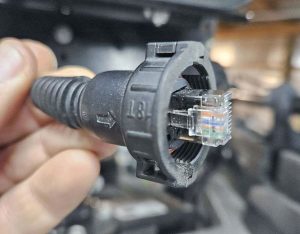Lowrance uses yellow Ethernet network ports to connect multiple sonar/GPS units.
Networking Multiple Sonar/GPS Units
Story and photos by Brad Wiegmann
Just how easy is it to network two or three sonar/GPS units together so they actually “talk to each other?”
Not nearly as difficult as many anglers imagine.
By connecting multiple sonar/GPS units an angler can share information such as sonar and detailed mapping from different sources connected to other units.
Every marine electronics company boasts their own networking capabilities. Garmin, Humminbird, and Lowrance have systems that allow anglers to network units together. It sounds too good to be true, but in most situations, networking is as easy as plugging in the correct ethernet cable from one unit to the other. Keep in mind, however, that different brands of sonar/GPS units will not and will never be able to connect to other brands.

Before you go out and purchase ethernet cables to connect your two sonar/GPS units make sure they have network port compatibility. It’s common for marine electronic companies to limit the ports available according to the sonar/GPS unit. To find marine network port compatibility between sonar/GPS units go to the marine electronic company’s website and it will normally be under support like Garmin’s Support Center.
Once the ethernet cable is connected, the two units can share sonar and mapping. However, map-sharing depends on the unit and possibly map cards within the units. There is no way to cover all the different scenarios possible with all the marine electronic companies, but just keep in mind you should do some research before purchasing your sonar/GPS units as to compatibilities. Some sonar/GPS units only require one unit to have mapping to share to a second unit.
Setting up sonar/GPS units with only one ethernet network cable port each is easy as plugging in each unit’s port. With compatible units it will share sonar, side imaging, down imaging, waypoints and mapping.
Typically, an angler will connect the front bow unit to a second unit on the console allowing the two units to communicate. Both locations allow for faster, easier waypointing brush piles, structure or hot fishing spots. At the console, anglers usually waypoint the same as the bow, but can also mark navigational hazardous areas like standing timber, rock piles, boulders or locations to boat docks and ramp areas.
Note the sonar transducer connected to the sonar/GPS unit is the only unit that can control the settings of the transducer. Mapping, trails, routes and waypoints that are shared between two sonar/GPS units, but like sonar are controlled by only one unit.
If you have multiple sonar/GPS units in the bow of the boat it’s common to network the front deck sonar/GPS units to the sonar/GPS unit at the console. The front two sonar/GPS units will need to have at least two ethernet network cable ports. The second sonar/GPS unit on the bow in most boats today is going to have the forward-facing sonar ethernet network cable plugged into one of those units.
From Springdale, Arkansas, Brad Wiegmann is a professional photographer, videographer and outdoor writer published in dozens of print and electronic media outlets all across the nation. Every month Wiegmann will be providing CrappieNOW readers with the latest and greatest information on the ever-changing world of fishing electronics. He is also a well-known guide, podcaster and social media influencer. Learn more about Wiegmann and his lengthy experience and expertise at BradWiegmann.com.



